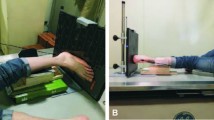Abstract
Background: Medial displaced posterior calcaneal tubercle creates varus deformity of an intraarticular calcaneal fracture. The fracture involves posterior calcaneal facet and the calcaneal body so we developed a measurement technique representing the angle between posterior facet and long axis of calcaneus using lateral malleolus and longitudinal bone trabeculae of posterior calcaneal tubercle as references to obtain calcaneal varus angle.
Materials and Methods: 52 axial view calcaneal radiographs of 26 volunteers were studied. Angles between posterior facet and long axis of calcaneus were measured using the measurements 1 and 2. Angle of measurement 1, as gold standard, was obtained from long axis and posterior facet of calcaneus whereas measurement 2 was obtained from a line, perpendicular to apex curve of lateral cortex of the lateral malleolus and a line parallel to the longitudinal bone trabeculae of posterior calcaneal tubercle. No more than 3° of difference in the angle of both measurements was accepted. Reliability of the measurement 2 was statistically tested.
Results: Angles of measurement 1 and 2 were 90.04° ± 4.00° and 90.58° ± 3.78°. Mean of different degrees of both measurements was 0.54° ± 2.31° with 95% of confidence interval: 0.10°-1.88°. The statistical analysis of measurement 1 and 2 showed more than 0.75 of ICC and 0.826 of Pearson correlation coefficient.
Conclusion: Technique of measurement 2 using lateral malleolus and longitudinal bone trabeculae of posterior calcaneal tubercle as references has strong reliability for representing the angle between long axis and posterior facet of calcaneus to achieve calcaneal varus angle.
Similar content being viewed by others
References
Harnroongroj T, Chuckpaiwong B, Angthong C, Nanakorn P, Sudjai N, Harnroongroj T. Displaced articular calcaneus fractures: Classification and fracture scores: A preliminary study. J Med Assoc Thai 2012;95:366–77.
Carr JB. Mechanism and pathoanatomy of the intraarticular calcaneal fracture. Clin Orthop Relat Res 1993;290:36–40.
Barak MM, Lieberman DE, Hublin JJ. A Wolff in sheep’s clothing: Trabecular bone adaptation in response to changes in joint loading orientation. Bone 2011;49:1141–51.
McGinnis PM. Biomechanics of Sport and Exercise. 2nd ed. Champaign, ILL: Human Kinetics; 2005. p. 243.
Magee DJ. Orthopedic Physical Assessment. 5th ed. St. Louis: Saunders Elsevier; 2008. p. 844.
Richardson ML, Van Vu M, Vincent LM, Sangeorzan BJ, Benirschke SK. CT measurement of the calcaneal varus angle in the normal and fractured hindfoot. J Comput Assist Tomogr 1992;16:261–4.
Reilingh ML, Beimers L, Tuijthof GJ, Stufkens SA, Maas M, van Dijk CN. Measuring hindfoot alignment radiographically: The long axial view is more reliable than the hindfoot alignment view. Skeletal Radiol 2010;39:1103–8.
Kohn E. Geometry (Cliffs Quick Review). New York: Hungry Minds Inc.; 2001.
Author information
Authors and Affiliations
Corresponding author
Rights and permissions
About this article
Cite this article
Harnroongroj, T., Tangmanasakul, A., Choursamran, N. et al. Measurement technique of calcaneal varus from axial view radiograph. IJOO 49, 223–226 (2015). https://doi.org/10.4103/0019-5413.152489
Published:
Issue Date:
DOI: https://doi.org/10.4103/0019-5413.152489
Key words
- Intraarticular calcaneal fracture
- lateral malleolus
- longitudinal bone trabeculae
- posterior calcaneal tubercle
- posterior calcaneal facet




